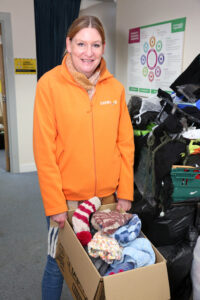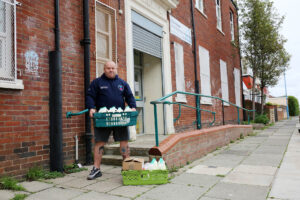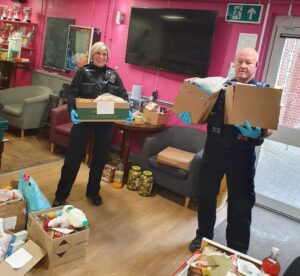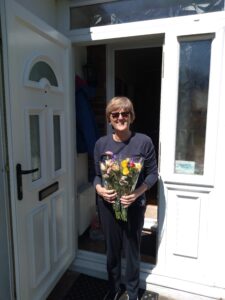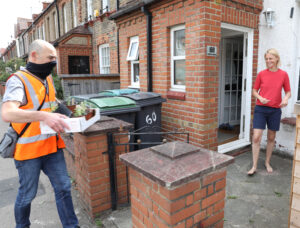Learning from nine months of crisis response
Since March 2020, Rob Macmillan from the Centre for Regional Economic and Social Research and the Third Sector Research Centre (TSRC) have been undertaking a rapid research project into how communities respond to and recover from COVID-19. As 2020 comes to an end, Rob takes a look back at what we’ve learned so far.
The short days and dark nights in the weeks running up to Christmas are often seen as a time to reflect on the highs and lows of the previous 12 months. As the unprecedented year of 2020 draws to a close we might be forgiven for wanting to put it all to one side; to forget the fact that we’ve been muddling and struggling through on extended pause since March. But this is an important opportunity to look back at what we’ve been through during COVID-19, what we’ve learnt, and what it means.
Communities across the country have done some amazing things during the year to meet extraordinary challenges. Despite the frustrations and ongoing challenges of the second wave of the virus and economic instability ahead, we should remember and cherish the kindness and solidarity we were able to generate amongst people we barely knew.
Financial and human resources have been brought together by communities to respond quickly to community needs.”
Whilst the crisis was gathering pace in March 2020, Local Trust commissioned a research team coordinated by the Third Sector Research Centre at Birmingham University and led by Angus McCabe and Mandy Wilson, to carry out a real-time investigation into community responses to COVID-19.
The study was originally conceived as an exploration of two broad questions:
- how communities respond to the crisis
- how communities recover from the crisis.
In hindsight this seems to have been perhaps optimistic – it still feels like we are quite a way off anything that could be regarded as recovery. So, as we reflect on the year gone by, what has been the main learning from the study? We can point to five main sets of arguments and observations.
First, the main explanations of varied community responses to disasters and crises tend to rely on the ideas of social capital (networks, trust and common norms) and community resilience (the ability to withstand, adapt to or ‘bounce back’ from adversity). Although both are in widespread use, there are limitations; in particular, that communities are to fall back on their own capacities, are held responsible for ‘coping with’ or ‘managing’ difficult situations, and thus their own fate.
COVID-19 reminds us that volunteering is a collective expression of community, mutualism, solidarity and care.”
In contrast, we have suggested that community resourcefulness better encapsulates the more pro-active capacity of communities to develop creative solutions, whilst understanding their location in uneven systems of power and resources. This is evident in how, for example, both financial and human resources have been brought together by communities to respond quickly and appropriately to community needs.
Second, there is a tendency to identify communities simply as a bottom up and informal ‘first responder’ in disasters and crises, in contrast to formal, top-down ‘command-and-control’ hierarchical emergency response systems. Yet this overlooks the extent to which informal and formal practices blend together.
We have seen how informality and formality are not binary opposites – during the pandemic some formal organisations have adopted more informal ways of working, whilst some informal community groups have moved towards more formal structures in order to access certain services. Informal work made significant, fast and flexible contributions to the crisis, but also involved collaboration and connecting with more formal systems, especially where there has been some form of investment in community infrastructure.
Third, although volunteering nationally and locally in communities has been seen as a remarkably positive and crucial feature of the response to the crisis, it is worth noting that alongside new volunteers making practical contributions, many have had to stop volunteering or shift their activities in the face of health concerns and restrictions. Although attention has traditionally been placed on individual motivations to volunteer, COVID-19 reminds us that volunteering is also a collective expression of community, mutualism, solidarity and care.
The research suggests that an effective local response is underpinned by rich and established community-led infrastructure.”
We saw that across our study areas, residents tend not to speak of themselves as volunteers, but rather as ‘just getting on with what needs to be done’ in their neighbourhood and community. However, there are concerns that as the pandemic continues expectations about the role and contribution volunteers can make have increased, especially when the need for public services will increase, but the budgets to pay for them are squeezed.
Fourth, we have noted how the COVID-19 crisis has led to a renewed interest in the idea of ‘infrastructure’ – the background structures and systems that enable things to happen. Within this we developed the idea of community-led infrastructure (CLI) to remedy the gaps left by voluntary sector and social infrastructure. CLI is focused on the needs of the wider community rather than focusing on a single cause or group and is defined by community ownership and control.
Based on our research in the 26 study areas, we saw that CLI underpinned fast and appropriate responses to community needs but also co-ordinated local action. CLI was characterised by connected networks of residents, trusted relationships at community level, community leadership in a credible resident-led structure and relationships with agencies. It was enabled by a physical or virtual meeting space or base, access to money and support by paid workers and facilitators.
We might want to forget the last nine months, but we should not overlook all the things that communities have achieved.”
And fifth, although the picture varies considerably across communities, we have seen just how strong community responses to COVID-19 can be. Most communities have moved on from the initial crisis response, but whereas some have been planning systematically for emerging and future community needs, others have struggled and felt a lack of control over events. The research to date suggests that an effective community response is underpinned by a rich and established community-led infrastructure. Where it is limited, the crisis response has primarily been food-focused; where it is richer and more established, the response has been wider ranging.
The research continues to follow how communities are making sense of the crisis, responding to it, and the extent to which they are planning for the next stages. Throughout the winter and towards spring 2021, the research will begin to consider the varied relationships between communities and other institutions, particularly local government, and the power dynamics within communities themselves.
Yet the crisis continues. It moves, ebbs, resurfaces, spreads and morphs from public health into a broader social and economic crisis. Many people are worn out, and ready for a break. We are still a long way from recovery. We might want to forget the last nine months, but we should not overlook all the things that communities have achieved in this time.

